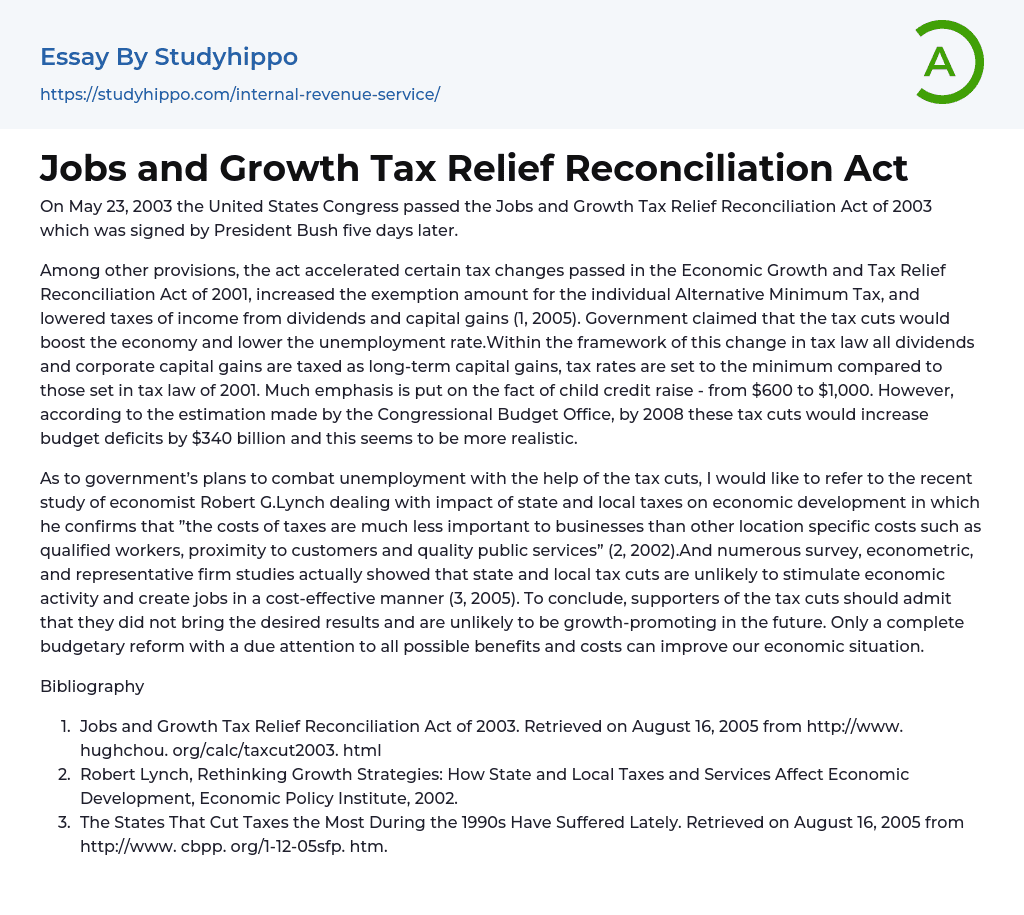

Jobs and Growth Tax Relief Reconciliation Act Essay Example
The Jobs and Growth Tax Relief Reconciliation Act of 2003 was passed by the United States Congress on May 23, 2003 and promptly signed into law by President Bush. This act included provisions that fast-tracked specific tax changes from the Economic Growth and Tax Relief Reconciliation Act of 2001. It also raised the exemption amount for the individual Alternative Minimum Tax, reduced taxes on income from dividends and capital gains (effective in 2005), and aimed to stimulate the economy while reducing unemployment. As a result, all dividends and corporate capital gains are now taxed as long-term capital gains at lower rates compared to previous legislation. Additionally, there was a significant increase in child credit from $600 to $1,000.
According to the Congressional Budget Office, government tax cuts would result in a $340 billion increase in budget deficits by 2008 (source: Jobs and Growth Tax Relief Reconciliation Act of 2003).
...Economist Robert G. Lynch's research on economic development indicates that factors such as qualified workers, customer proximity, and quality public services are more significant to businesses than taxes (source: Robert Lynch, Rethinking Growth Strategies: How State and Local Taxes and Services Affect Economic Development, Economic Policy Institute, 2002).
Multiple studies have demonstrated that reductions in state and local taxes do not effectively stimulate economic activity or create jobs. Therefore, proponents of tax cuts must acknowledge that desired outcomes have not been achieved and future growth is unlikely to be fostered (source: During the 1990s, states that reduced taxes the most experienced recent hardships).
To enhance the economy, it is imperative to implement comprehensive budgetary reform considering all potential benefits and costs.
The webpage "cbpp.org/1-12-05sfp.htm" is shown within the paragraph tag.
- American Dream essays
- Barriers To Entry essays
- Capitalism essays
- Central Bank essays
- Compensation essays
- Consumerism essays
- Economic Development essays
- Economic Growth essays
- Economic Inequality essays
- Economic System essays
- Economy essays
- Employment essays
- Export essays
- Finance essays
- Free Trade essays
- Gross Domestic Product essays
- Human Development essays
- Income Inequality essays
- Industry essays
- Inflation essays
- International Business essays
- International Trade essays
- Macroeconomics essays
- Materialism essays
- Max Weber essays
- Microeconomics essays
- Minimum Wage essays
- Monetary Policy essays
- Monopoly essays
- Pricing essays
- Profit essays
- Recession essays
- resources essays
- Taxation essays
- Trade essays
- Unemployment essays
- Warehouse essays
- World economy essays
- Career Choice essays
- Career Goals essays
- Career Plan essays
- Community Service essays
- Dream Job essays
- Duty essays
- Employee essays
- Internship essays
- Interview essays
- Job essays
- Job Interview essays
- Performance Appraisal essays



